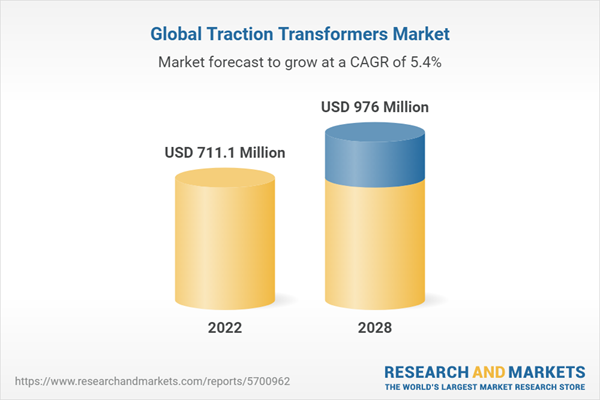A traction transformer is an electronic device that transfers energy from one circuit to another through electromagnetic induction. It is a crucial component of the electric traction mechanism, which consists of direct current (DC) and alternating current (AC) systems. It is commonly used in high-speed and passenger trains, locomotives, trams and metro rails. The device is mounted inside the machine room of the locomotive, on top or under the roof to obtain maximum reliability and flexibility of multiphase and single systems. In comparison to traditionally used variants, traction transformers significantly aid in reducing operating costs, are lightweight and can provide higher power output.
The growth of the high-speed rail sector and significant advancements in railway infrastructure are among the key factors driving the growth of the market. Furthermore, the rapid electrification of rail networks is expected to increase the demand for traction transformers across the globe. The governments of emerging nations are implementing favorable policies to improve the existing transportation facilities and optimize rail systems. Widespread adoption of traction transformers in both traditional and next-generation locomotives to support faster-commuting networks, the rapidly increasing number of passengers and diversifying travel routes are further driving the product demand. In addition to this, growing awareness regarding the utilization of energy-efficient products for reducing the environmental damage caused by outdated technologies is resulting in the increasing adoption of AC transformers worldwide. Also, since these transformers are not dependent on conventional sources of energy, such as crude oil and coal, they offer an eco-friendly and convenient solution. Other factors, including innovations to develop equipment with minimal noise, carbon emissions, power losses and operating costs, are projected to create a positive outlook for the market.
Key Market Segmentation:
The publisher provides an analysis of the key trends in each segment of the global traction transformers market report, along with forecasts at the global, regional and country levels from 2023-2028. The report has categorized the market based on type, rolling stock, mounting position and overhead line voltage.Breakup by Type:
- Tap Changing
- Tapped
- Rectifier
Breakup by Rolling Stock:
- Electric Locomotives
- High-Speed Trains
- Metros
- Others
Breakup by Mounting Position:
- Underframe
- Machine Room
- Roof
Breakup by Overhead Line Voltage:
- Alternative Current (AC) Systems
- Direct Current (DC) Systems
Breakup by Region:
- North America
- United States
- Canada
- Europe
- Germany
- France
- United Kingdom
- Italy
- Spain
- Russia
- Others
- Asia Pacific
- China
- Japan
- India
- South Korea
- Australia
- Indonesia
- Others
- Latin America
- Brazil
- Mexico
- Others
- Middle East and Africa
Competitive Landscape:
The competitive landscape of the industry has also been examined with some of the key players being ABB Limited, Alstom Holdings, EMCO Limited, Hind Rectifiers Limited, International Electric Corporation Limited, JST Transformateurs, Schneider Electric SA, Setrans Holding AS, Siemens Aktiengesellschaft, and Wilson Transformer Company, etc.Key Questions Answered in This Report:
- How has the global traction transformers market performed so far and how will it perform in the coming years?
- What are the key regional markets?
- What has been the impact of COVID-19 on the global traction transformers market?
- What is the breakup of the market based on the type?
- What is the breakup of the market based on the rolling stock?
- What is the breakup of the market based on the mounting position?
- What is the breakup of the market based on the overhead line voltage?
- What are the various stages in the value chain of the industry?
- What are the key driving factors and challenges in the market?
- What is the structure of the global traction transformers market and who are the key players?
- What is the degree of competition in the market?
Table of Contents
Companies Mentioned
- ABB Limited
- Alstom Holdings
- EMCO Limited
- Hind Rectifiers Limited
- International Electric Corporation Limited
- JST Transformateurs
- Schneider Electric SA
- Setrans Holding AS
- Siemens Aktiengesellschaft
- Wilson Transformer Company
Methodology

LOADING...
Table Information
| Report Attribute | Details |
|---|---|
| No. of Pages | 143 |
| Published | September 2023 |
| Forecast Period | 2022 - 2028 |
| Estimated Market Value ( USD | $ 711.1 Million |
| Forecasted Market Value ( USD | $ 976 Million |
| Compound Annual Growth Rate | 5.4% |
| Regions Covered | Global |
| No. of Companies Mentioned | 10 |









